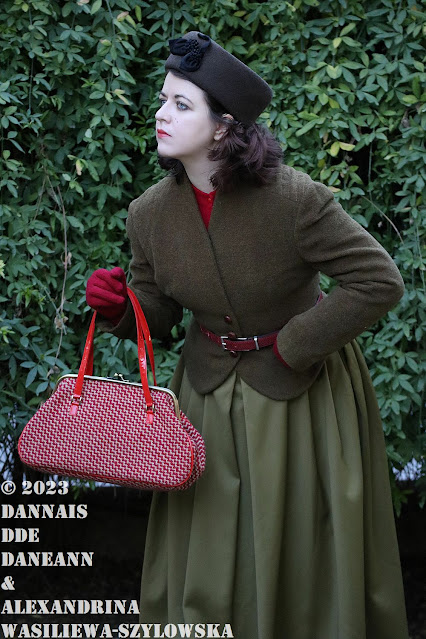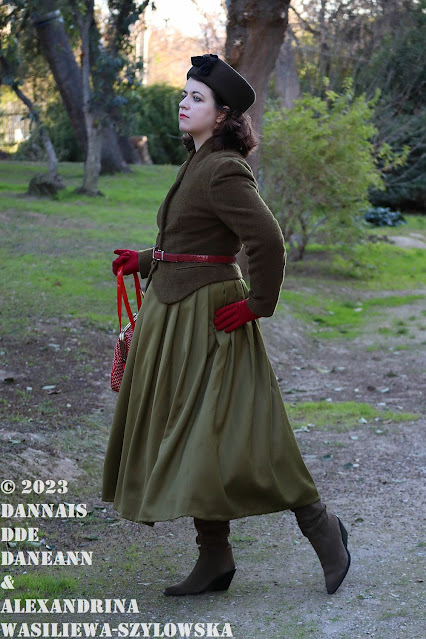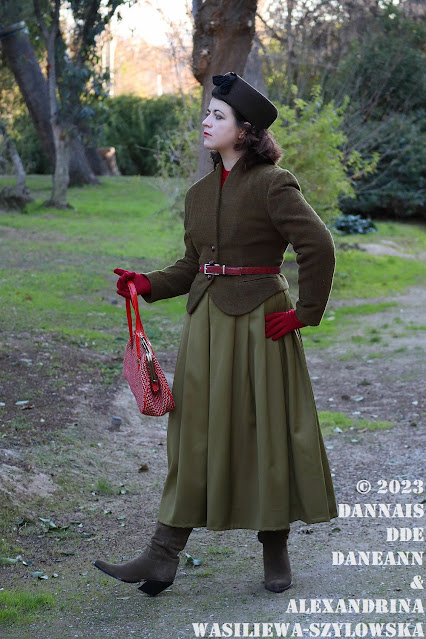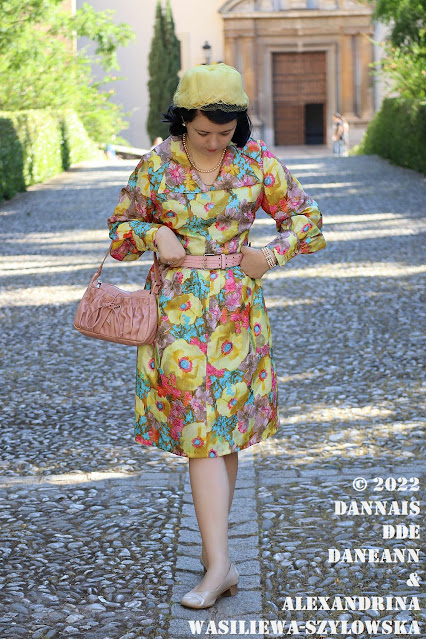Archive of 2022-2023: Cool winter outfit in style of the 1915 with real vintage toque hat & cardigan
Finding really vintage fitted cardigans is very difficult. Basically they are very expensive. And most stores - both vintage and secondhand - are flooded with long and shapeless modern options.
My cardigan is an excellent example of vintage - fitted and decorated. Moreover, rhinestones are not glued and not made of plastic, but sewn and made of glass.
I paired the cardigan with a high waist button detail flare maxi skirt. To emphasize the high waist of the skirt, I tucked the cardigan into it.
I paired the cardigan with a high waist button detail flare maxi skirt. To emphasize the high waist of the skirt, I tucked the cardigan into it.
I put on a fitted jacket over the cardigan. This time, I picked up a toque-style hat for my new toilet.

But what is this hat?

The history of the hat began with the Crusades. The traditional oriental fez headdress served as the prototype of the toque hat.
The toque hat was popular in the 13th and 16th centuries. Then such hats were worn by both men and women. Was a frequent addition to the Spanish skeleton suit.
However, despite this, in 1863 a new form of hat came into fashion, which was sometimes coquettishly called “fizgig” in some countries and about which magazines wrote the following:
“This is a very small hat, barely covering the cheeks; but such a style will not withstand the first sunrays."
That time, similar small hats began to be called "toque" and their popularity had lasted for almost a century, because they began to be worn with sun umbrellas.
In the 1860s, "toques" were lavishly decorated with feathers, jeweled agraphs, and buckles. In the second half of the 19th century, the “toque” decoration became more modest, the size of the hat decreased.
At the beginning of the 20th century, the silk toque became part of the then-popular bold image of an oriental beauty, which was introduced into fashion by the Parisian fashion designer Paul Poiret. The toque popularity peaked in the 1930s, but continued into the 1940s and 1950s.
In my opinion, the next development of the toque hat was the pillbox hat, but I will talk about it sometime later.
The toque hat was popular in the 13th and 16th centuries. Then such hats were worn by both men and women. Was a frequent addition to the Spanish skeleton suit.
In the last quarter of the 16th century, it became a particularly fashionable headdress in France and received its modern name "toque". This word translated from French means "hat without a brim." By about the 19th century, gentlemen completely gave way to this headdress for ladies.
In the first half of the 19th century, toques were large and significantly different from those we are used today. Similar styles can be seen in Napoleonic heraldry, which replaced the former crowns in the arms of the new nobility created by Napoleon I as a symbol of titles. The toque crowned the armorial shield.
But back to fashion. In those days, toques were lavishly decorated with flowers and feathers. In addition, then they were not much different from turbans. Their main difference was that the turban was draped with the help of a hairdresser, and the toque was a finished hat. At that time, several types of toque were common: Russian, Turkish, Indian and Spanish.
It is known that the passion for tanning dates back to the violent twentieth century, but in the nineteenth it was fashionable to have a pale complexion. Then the ladies avoided the sun, and, therefore, the hat had to cover the face. By the way, I live the same lifestyle. The sun is in the sky - the hat is on the head - the face is in its protective shadow.
However, despite this, in 1863 a new form of hat came into fashion, which was sometimes coquettishly called “fizgig” in some countries and about which magazines wrote the following:
“This is a very small hat, barely covering the cheeks; but such a style will not withstand the first sunrays."
That time, similar small hats began to be called "toque" and their popularity had lasted for almost a century, because they began to be worn with sun umbrellas.
In the 1860s, "toques" were lavishly decorated with feathers, jeweled agraphs, and buckles. In the second half of the 19th century, the “toque” decoration became more modest, the size of the hat decreased.
Here is how Count Leo Tolstoy described the headdress of Princess Betsy Tverskoy in his immortal Anna Karenina:
"Her hat, hovered somewhere above her head, like a cap over a lamp...".
"Her hat, hovered somewhere above her head, like a cap over a lamp...".
At the beginning of the 20th century, the silk toque became part of the then-popular bold image of an oriental beauty, which was introduced into fashion by the Parisian fashion designer Paul Poiret. The toque popularity peaked in the 1930s, but continued into the 1940s and 1950s.
In my opinion, the next development of the toque hat was the pillbox hat, but I will talk about it sometime later.
I am wearing:
I think I ended up with an outfit in the style of the 1910s, specifically 1915 - elegant, a little bit paramilitary, a little bit folklorish.
- Real vintage mustard olive pure wool fitted jacket with quilted back by “Lory”, made in Italy, about 1970s (not earlier then 1973)
- Real vintage red pure wool long sleeve button down cardigan with silver thread stars embroidery and glass rhinestones, about 1940s-1950s
- Real vintage handmade amber green pure wool high waist button detail flare maxi skirt, about 1970s
- (not seen) White cotton petticoat, about 1990s-2010s
- (not seen) Black pure silk petticoat, about 2010s
- Real vintage olive green pure wool felt toque hat with black sateen décor, about 1960s
- Handmade dark red leather belt by “ReVolt”, Italian style by Remo Salvador, made in Italy, about 1990-2000s
- Red and white wool tweed carpetbag with red patent leather handles and metal closure by “Z & L”, made in India, about 2000s
- Dark red pure wool gloves with cuffs, about 1990s-2000s
- Tan brown suede very high booties (City Western Boots) with black asymmetrical mid-high wooden heels by “BRONX”, 2010s-2020s, made in India















































Comments
Post a Comment